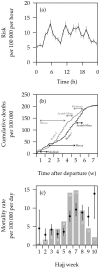Causes of mortality for Indonesian Hajj Pilgrims: comparison between routine death certificate and verbal autopsy findings
- PMID: 23991182
- PMCID: PMC3749149
- DOI: 10.1371/journal.pone.0073243
Causes of mortality for Indonesian Hajj Pilgrims: comparison between routine death certificate and verbal autopsy findings
Abstract
Background: Indonesia provides the largest single source of pilgrims for the Hajj (10%). In the last two decades, mortality rates for Indonesian pilgrims ranged between 200-380 deaths per 100,000 pilgrims over the 10-week Hajj period. Reasons for high mortality are not well understood. In 2008, verbal autopsy was introduced to complement routine death certificates to explore cause of death diagnoses. This study presents the patterns and causes of death for Indonesian pilgrims, and compares routine death certificates to verbal autopsy findings.
Methods: Public health surveillance was conducted by Indonesian public health authorities accompanying pilgrims to Saudi Arabia, with daily reporting of hospitalizations and deaths. Surveillance data from 2008 were analyzed for timing, geographic location and site of death. Percentages for each cause of death category from death certificates were compared to that from verbal autopsy.
Results: In 2008, 206,831 Indonesian undertook the Hajj. There were 446 deaths, equivalent to 1,968 deaths per 100,000 pilgrim years. Most pilgrims died in Mecca (68%) and Medinah (24%). There was no statistically discernible difference in the total mortality risk for the two pilgrimage routes (Mecca or Medinah first), but the number of deaths peaked earlier for those traveling to Mecca first (p=0.002). Most deaths were due to cardiovascular (66%) and respiratory (28%) diseases. A greater proportion of deaths were attributed to cardiovascular disease by death certificate compared to the verbal autopsy method (p<0.001). Significantly more deaths had ill-defined cause based on verbal autopsy method (p<0.001).
Conclusions: Despite pre-departure health screening and other medical services, Indonesian pilgrim mortality rates were very high. Correct classification of cause of death is critical for the development of risk mitigation strategies. Since verbal autopsy classified causes of death differently to death certificates, further studies are needed to assess the method's utility in this setting.
Conflict of interest statement
Figures


References
-
- Alzahrani AG, Choudhry AJ, Al Mazroa, Turkistani AH, Nouman GS et al. (2012) Pattern of diseases among visitors to Mina health centers during the Hajj season, 1429 H (2008 G). J Infect Public Health 5: 22-34. doi:10.1016/j.jiph.2011.10.003. PubMed: 22341840. - DOI - PubMed
-
- Shafi S, Booy R, Haworth E, Rashid H, Memish ZA (2008) Hajj: health lessons for mass gatherings. J Infect Public Health 1: 27-32. doi:10.1016/j.jiph.2008.08.008. PubMed: 20701842. - DOI - PubMed
-
- Gautret P, Soula G, Delmont J, Parola P, Brouqui P (2009) Common health hazards in French pilgrims during the Hajj of 2007: a prospective cohort study. J Travel Med 16: 377-381. doi:10.1111/j.1708-8305.2009.00358.x. PubMed: 19930376. - DOI - PubMed
-
- Mandourah Y, Ocheltree A, Al Radi A, Fowler R (2012) The epidemiology of Hajj-related critical illness: lessons for deployment of temporary critical care services*. Crit Care Med 40: 829-834. doi:10.1097/CCM.0b013e318236f49b. PubMed: 22080635. - DOI - PubMed
-
- Kesehatan Departemen (2007) Profil Kesehatan Haji, 2006-2007. Jakarta: Ditjen PP&PL.
Publication types
MeSH terms
LinkOut - more resources
Full Text Sources
Other Literature Sources

